HONDA S2000 2003 1.G Owner's Guide
Manufacturer: HONDA, Model Year: 2003, Model line: S2000, Model: HONDA S2000 2003 1.GPages: 280, PDF Size: 3.9 MB
Page 31 of 280
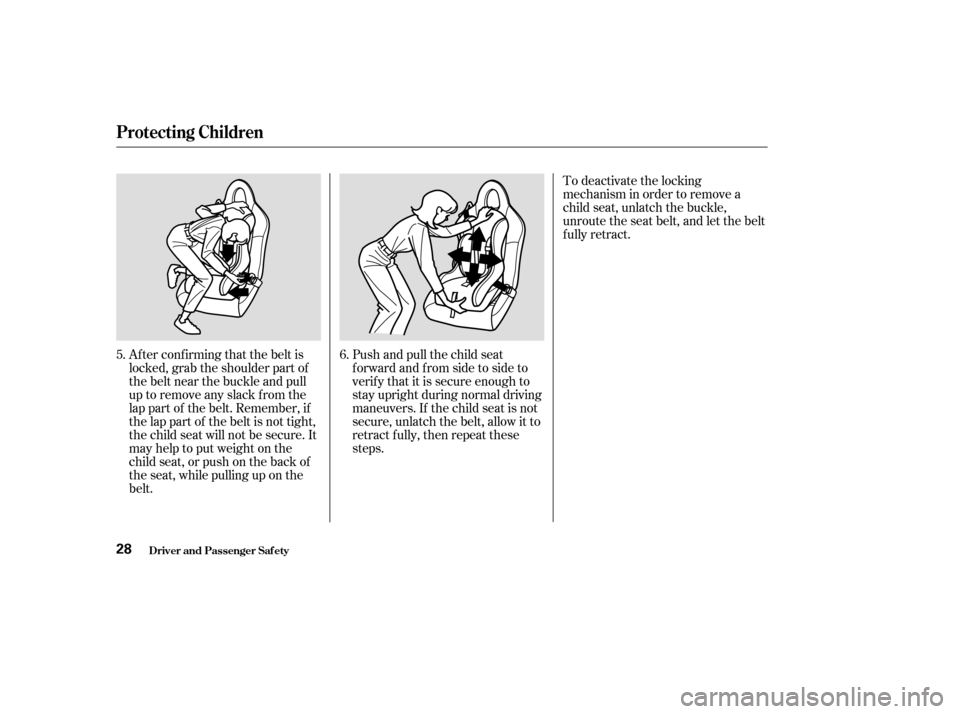
Af ter conf irming that the belt is
locked, grab the shoulder part of
the belt near the buckle and pull
up to remove any slack from the
lap part of the belt. Remember, if
the lap part of the belt is not tight,
the child seat will not be secure. It
mayhelptoputweightonthe
child seat, or push on the back of
the seat, while pulling up on the
belt.Push and pull the child seat
f orward and f rom side to side to
verif y that it is secure enough to
stay upright during normal driving
maneuvers. If the child seat is not
secure, unlatch the belt, allow it to
retract f ully, then repeat these
steps.To deactivate the locking
mechanism in order to remove a
child seat, unlatch the buckle,
unroute the seat belt, and let the belt
fully retract.
5. 6.
Protecting Children
Driver and Passenger Saf ety28
Page 32 of 280
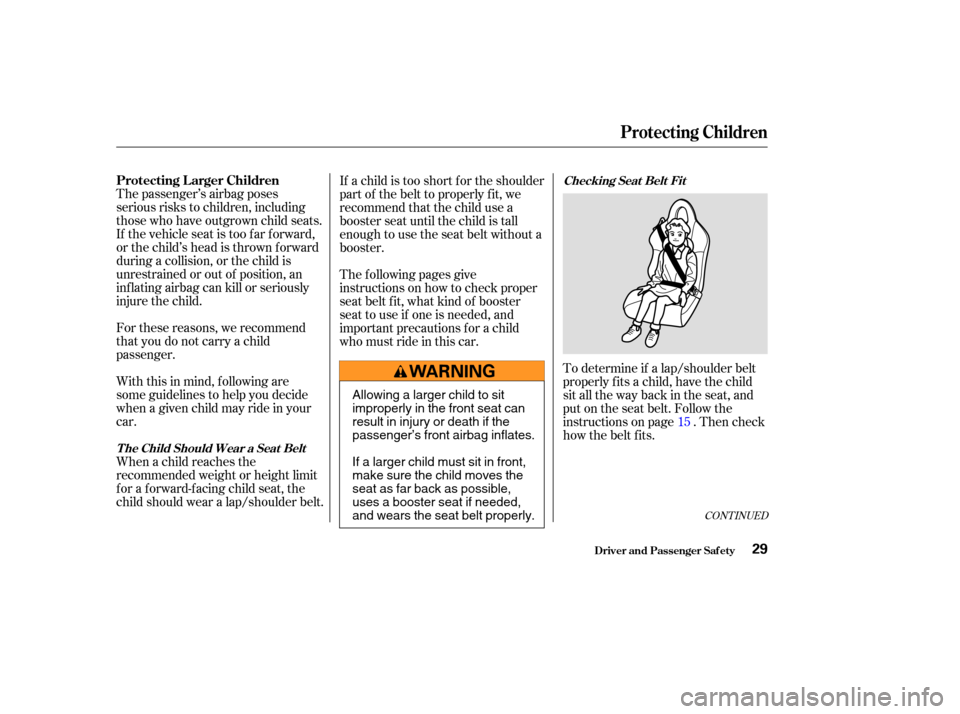
The passenger’s airbag poses
serious risks to children, including
those who have outgrown child seats.
If the vehicle seat is too f ar f orward,
or the child’s head is thrown f orward
during a collision, or the child is
unrestrained or out of position, an
inf lating airbag can kill or seriously
injure the child.
For these reasons, we recommend
that you do not carry a child
passenger.
With this in mind, f ollowing are
some guidelines to help you decide
when a given child may ride in your
car.
When a child reaches the
recommended weight or height limit
for a forward-facing child seat, the
child should wear a lap/shoulder belt.If a child is too short f or the shoulder
part of the belt to properly f it, we
recommend that the child use a
booster seat until the child is tall
enough to use the seat belt without a
booster.
The f ollowing pages give
instructions on how to check proper
seat belt f it, what kind of booster
seat to use if one is needed, and
important precautions f or a child
who must ride in this car.
To determine if a lap/shoulder belt
properly f its a child, have the child
sit all the way back in the seat, and
put on the seat belt. Follow the
instructions on page . Then check
how the belt f its.15
CONT INUED
Checking Seat Belt Fit
T he Child Should Wear a Seat BeltProtecting L arger Children
Protecting Children
Driver and Passenger Saf ety29
Allowing a larger child to sit
improperly in the front seat can
result in injury or death if the
passenger’s front airbag inflates.
If a larger child must sit in front,
make sure the child moves the
seat as far back as possible,
uses a booster seat if needed,
and wears the seat belt properly.
Page 33 of 280

Whichever style you select, f ollow
the booster seat maker’s instructions.
If the shoulder part of the belt rests
over the child’s collarbone and
against the center of the chest, and
the lap belt rests over the child’s
hipbones and touches the tops of the
thighs as shown, the child is
probably big enough to wear the seat
belt.
However, if the shoulder belt
touchesorcrossesthechild’sneck,
or if the lap belt crosses the child’s
stomach, the child needs to use a
booster seat.
This could result in serious neck and
internal injuries during a crash.
If a child needs a booster seat, we
recommend choosing a high or low-
back style that allows the child to be
directly secured with the lap/
shoulder belt.
If they do, they could
be very seriously injured in a crash. Devices intended to improve
occupant comf ort or reposition the
shoulder part of a seat belt, severely
compromise the protective capability
of the seat belt and increase the
chance of serious injury in a crash. This could cause
very serious injuries during a crash.
It also increases the chance that the
child will slide under the belt in a
crash and be injured.
Using a Boost er Seat
Do not let a child wear a seat belt across t he neck or over t he st omach. T wo children should never use t he same seat belt .
Do not put any accessories on a seat
belt.
Do not let a child put the shoulder
part of a seat belt behind t he back orunder t he arm.
Protecting Children
Driver and Passenger Saf ety30
Page 34 of 280

CONT INUED
Children vary widely. And while age
may be one indicator of when a child
can saf ely ride in this car, there are
other important f actors you should
consider.Physically, a child must be large
enough f or the lap/shoulder belt to
properly f it over the hips, chest, and
shoulder (see pages and ). If
the seat belt does not f it properly,
the child should use a booster seat.
To saf ely ride in this car, a child
must be able to f ollow the rules,
including sitting properly and
wearing the seat belt properly
throughout a ride.
A child should continue using a
booster seat until the child exceeds
the booster seat manufacturer’s
requirements.
Even then, the child may still need to
use a booster seat. Note that some
states now require children to use
boosters until they reach a certain
ageand/orweight.Besuretocheck
current laws in the state or states
where you intend to drive.
2915
Physical Size
Maturity
When Can a L arger Child Ride in t his
Car
Protecting Children
Driver and Passenger Saf ety31
Page 35 of 280

Move the vehicle seat to the rear-
most position.
Check that the child’s seat belt is
properly positioned and secured. Have the child sit up straight, back
against the seat, and feet on or
near the f loor.Supervise the child. Even a mature
child sometimes needs to be
reminded to f asten the seat belt or
sit properly.
Caref ully read the owner’s manual
and make sure you understand all
seat belt instructions and all saf ety
inf ormation.
If you decide that a child can saf ely
ride in this car, be sure to:
Protecting Children
Driver and Passenger Saf ety32
Page 36 of 280
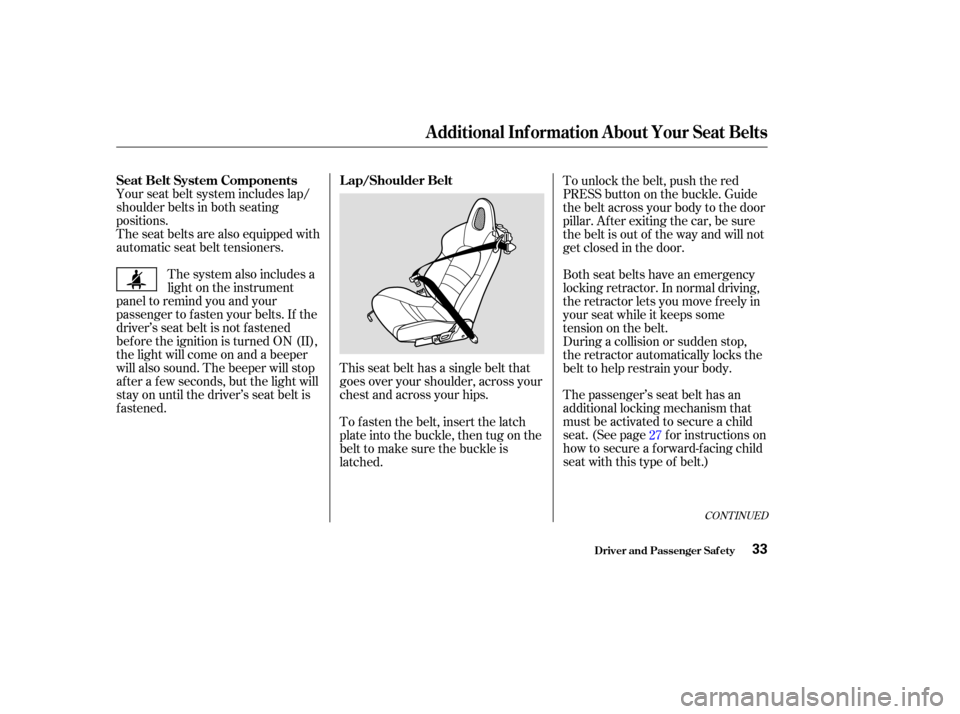
This seat belt has a single belt that
goes over your shoulder, across your
chest and across your hips.
Your seat belt system includes lap/
shoulder belts in both seating
positions.
The seat belts are also equipped with
automatic seat belt tensioners.
The system also includes a
light on the instrument
panel to remind you and your
passenger to f asten your belts. If the
driver’s seat belt is not f astened
before the ignition is turned ON (II),
the light will come on and a beeper
will also sound. The beeper will stop
af ter a f ew seconds, but the light will
stay on until the driver’s seat belt is
f astened. The passenger’s seat belt has an
additional locking mechanism that
must be activated to secure a child
seat. (See page for instructions on
how to secure a f orward-f acing child
seat with this type of belt.) Both seat belts have an emergency
locking retractor. In normal driving,
the retractor lets you move f reely in
your seat while it keeps some
tensiononthebelt.
During a collision or sudden stop,
the retractor automatically locks the
belt to help restrain your body. To unlock the belt, push the red
PRESSbuttononthebuckle.Guide
the belt across your body to the door
pillar. Af ter exiting the car, be sure
the belt is out of the way and will not
getclosedinthedoor.
To fasten the belt, insert the latch
plate into the buckle, then tug on the
belt to make sure the buckle is
latched. 27
CONT INUED
Seat Belt System Components L ap/Shoulder Belt
Additional Inf ormation About Your Seat Belts
Driver and Passenger Saf ety33
Page 37 of 280
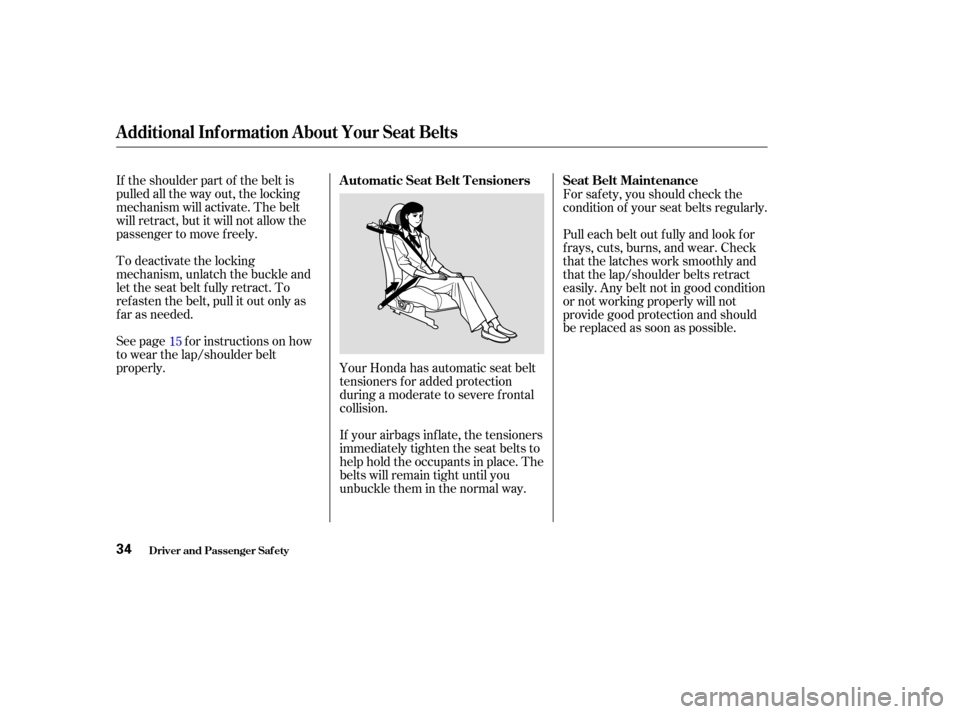
If the shoulder part of the belt is
pulled all the way out, the locking
mechanism will activate. The belt
will retract, but it will not allow the
passenger to move f reely.
To deactivate the locking
mechanism, unlatch the buckle and
let the seat belt f ully retract. To
ref asten the belt, pull it out only as
f ar as needed.
See page f or instructions on how
to wear the lap/shoulder belt
properly.For saf ety, you should check the
condition of your seat belts regularly.
Pull each belt out f ully and look f or
f rays, cuts, burns, and wear. Check
that the latches work smoothly and
that the lap/shoulder belts retract
easily. Any belt not in good condition
or not working properly will not
provide good protection and should
be replaced as soon as possible.
Your Honda has automatic seat belt
tensioners f or added protection
during a moderate to severe frontal
collision.
If your airbags inf late, the tensioners
immediately tighten the seat belts to
help hold the occupants in place. The
belts will remain tight until you
unbuckle them in the normal way.
15
Additional Inf ormation About Your Seat Belts
Driver and Passenger Saf ety
Seat Belt Maintenance
A utomatic Seat Belt T ensioners
34
Page 38 of 280
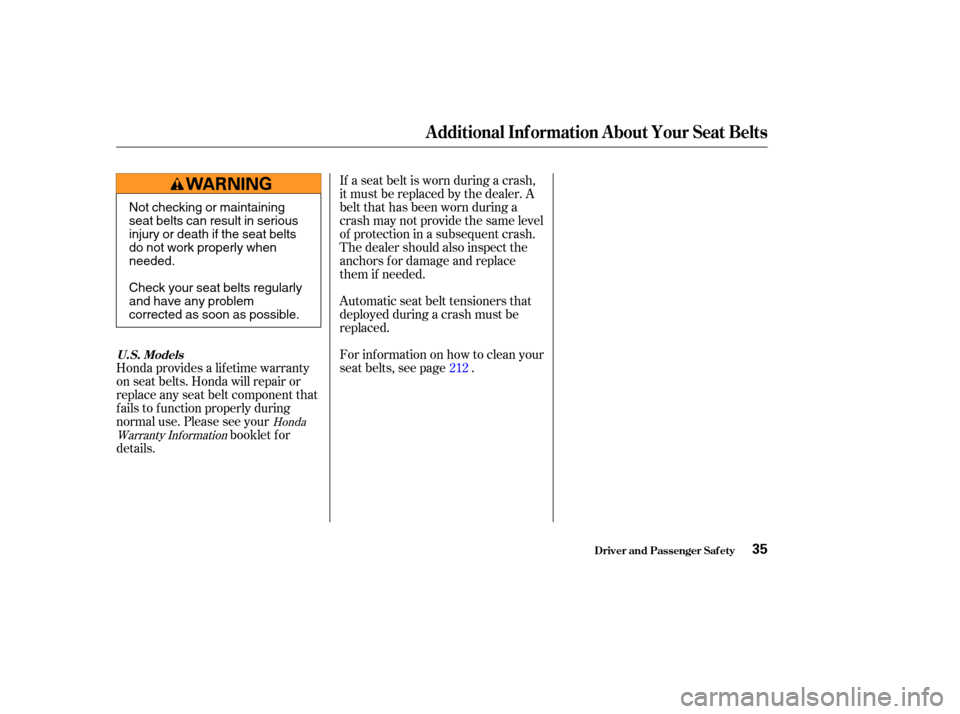
If a seat belt is worn during a crash,
it must be replaced by the dealer. A
belt that has been worn during a
crash may not provide the same level
of protection in a subsequent crash.
The dealer should also inspect the
anchors f or damage and replace
them if needed.
Honda provides a lif etime warranty
on seat belts. Honda will repair or
replace any seat belt component that
f ails to f unction properly during
normal use. Please see your booklet f or
details. Automatic seat belt tensioners that
deployed during a crash must be
replaced.
For inf ormation on how to clean your
seat belts, see page .
212
Honda
Warranty Inf ormation
Driver and Passenger Saf ety
U.S. Models
Additional Inf ormation About Your Seat Belts
35
Not checking or maintaining
seat belts can result in serious
injury or death if the seat belts
do not work properly when
needed.
Check your seat belts regularly
and have any problem
corrected as soon as possible.
Page 39 of 280

An indicator light on the
instrument panel that alerts you to
a possible problem with the
system (see page ).
Emergency backup power in case
your car’s electrical system is
disconnected in a crash.
Your Supplemental Restraint System
(SRS) includes:
Two f ront airbags. The driver’s
airbag is stored in the center of
the steering wheel; the f ront
passenger’sairbagisstoredinthe
dashboard. Both are marked ‘‘SRS
AIRBAG.’’
Automatic seat belt tensioners
(see page ).
Sensors that can detect a
moderate to severe frontal
collision.
A sophisticated electronic system
that continually monitors
inf ormation about the sensors, the
control unit, and the airbag
activators when the ignition is ON
(II). If you ever have a moderate to
severe f rontal collision, the sensors
will detect rapid deceleration and
signal the control unit to instantly
inflate the airbags and activate the
automatic seat belt tensioners.
34 38
Additional Inf ormation About Your SRS
Driver and Passenger Saf ety
SRS Components
How Your A irbags Work
36
Page 40 of 280
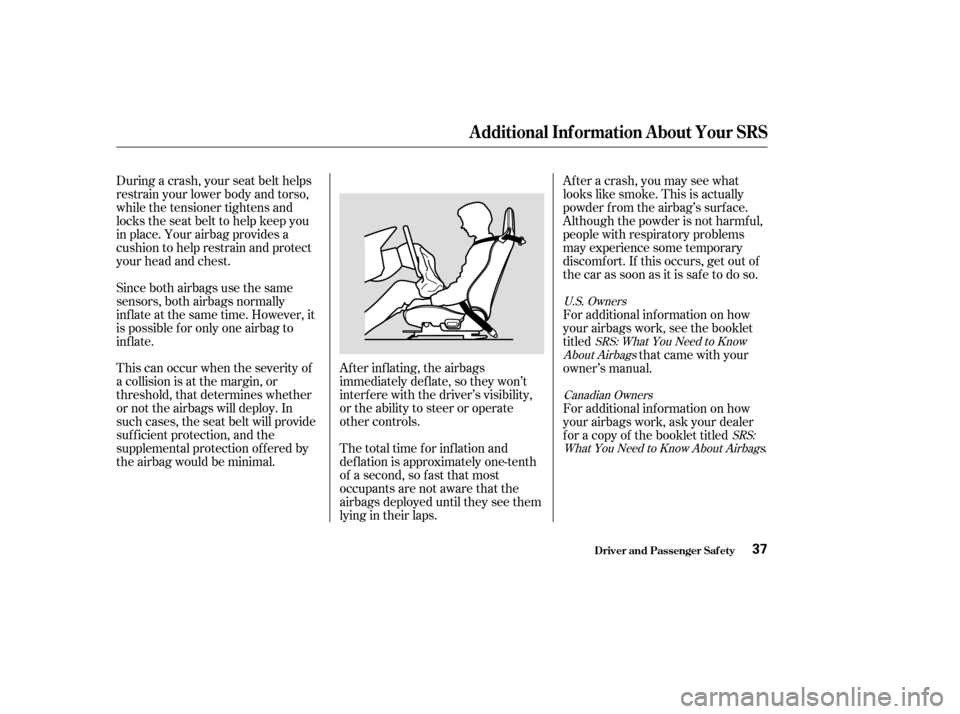
Af ter inf lating, the airbags
immediately def late, so they won’t
interf ere with the driver’s visibility,
or the ability to steer or operate
other controls.
The total time for inflation and
def lation is approximately one-tenth
of a second, so f ast that most
occupants are not aware that the
airbags deployed until they see them
lying in their laps.
This can occur when the severity of
a collision is at the margin, or
threshold, that determines whether
or not the airbags will deploy. In
such cases, the seat belt will provide
suf f icient protection, and the
supplemental protection of f ered by
the airbag would be minimal. During a crash, your seat belt helps
restrain your lower body and torso,
while the tensioner tightens and
locks the seat belt to help keep you
in place. Your airbag provides a
cushion to help restrain and protect
your head and chest.
Since both airbags use the same
sensors, both airbags normally
inf late at the same time. However, it
is possible f or only one airbag to
inf late. After a crash, you may see what
looks like smoke. This is actually
powder f rom the airbag’s surf ace.
Although the powder is not harmf ul,
people with respiratory problems
mayexperiencesometemporary
discomf ort. If this occurs, get out of
the car as soon as it is safe to do so.
For additional information on how
your airbags work, see the booklet
titled
that came with your
owner’s manual.
For additional information on how
your airbags work, ask your dealer
f or a copy of the booklet titled
SRS: What You Need to Know
About Airbags
SRS:
What You Need to Know About Airbags
.
U.S. Owners
Canadian Owners
Driver and Passenger Saf ety
Additional Inf ormation About Your SRS
37